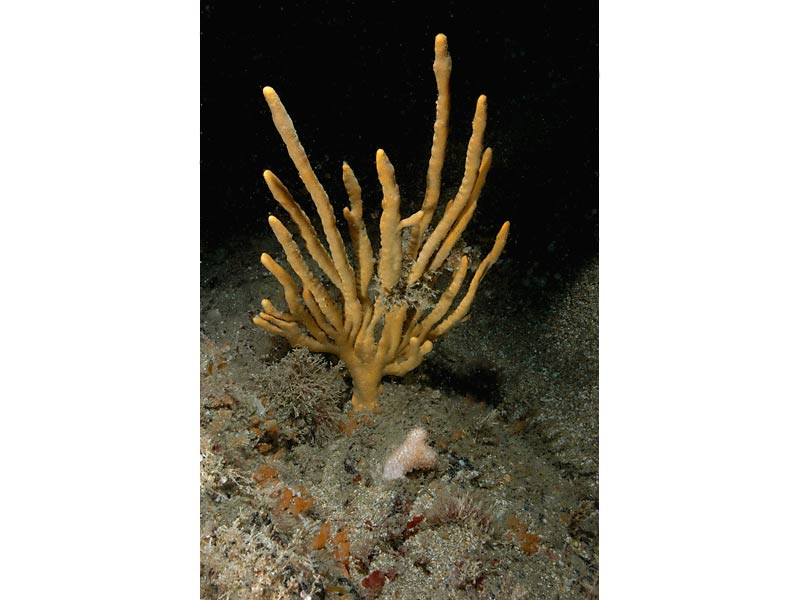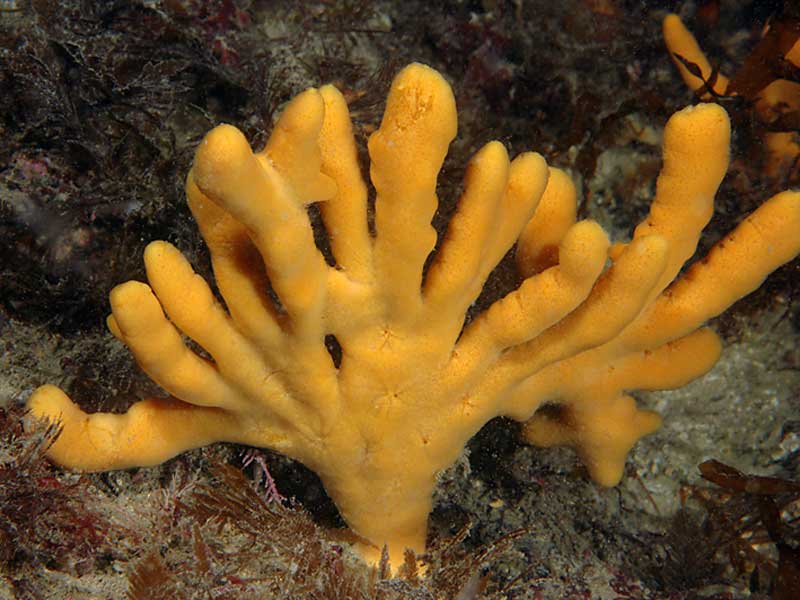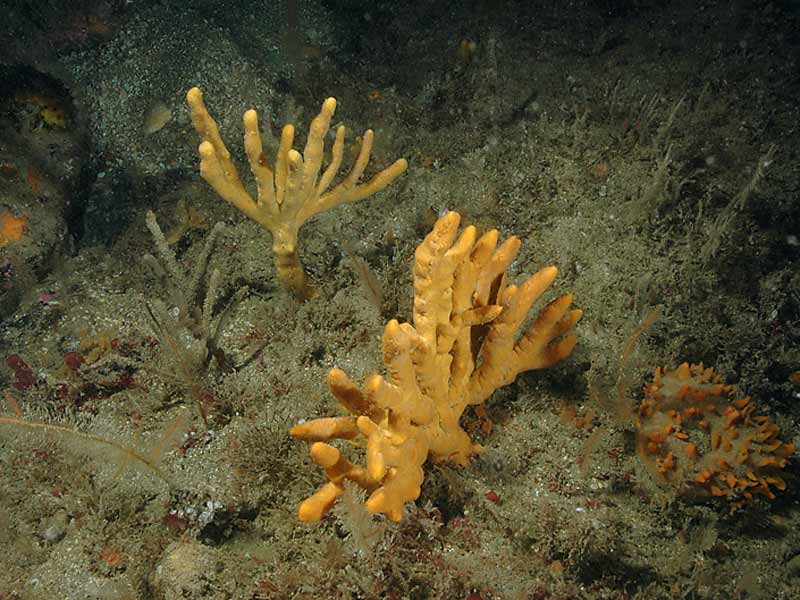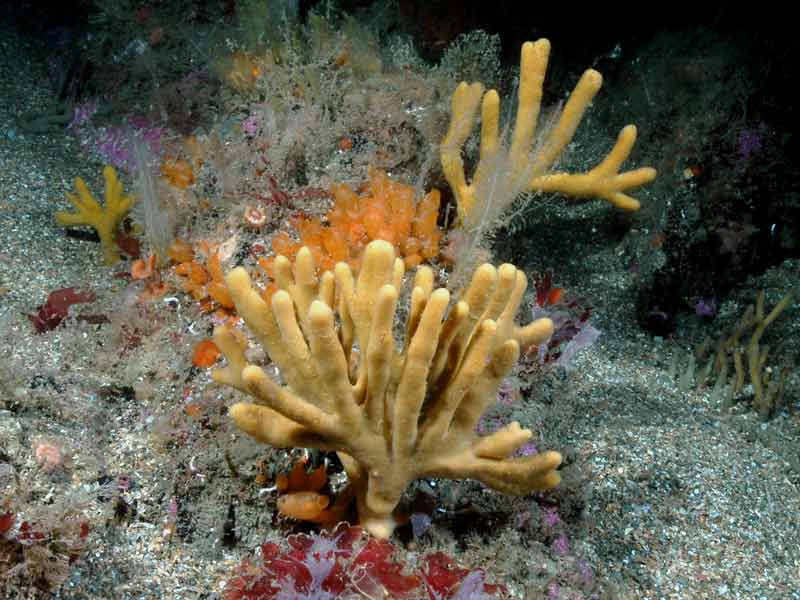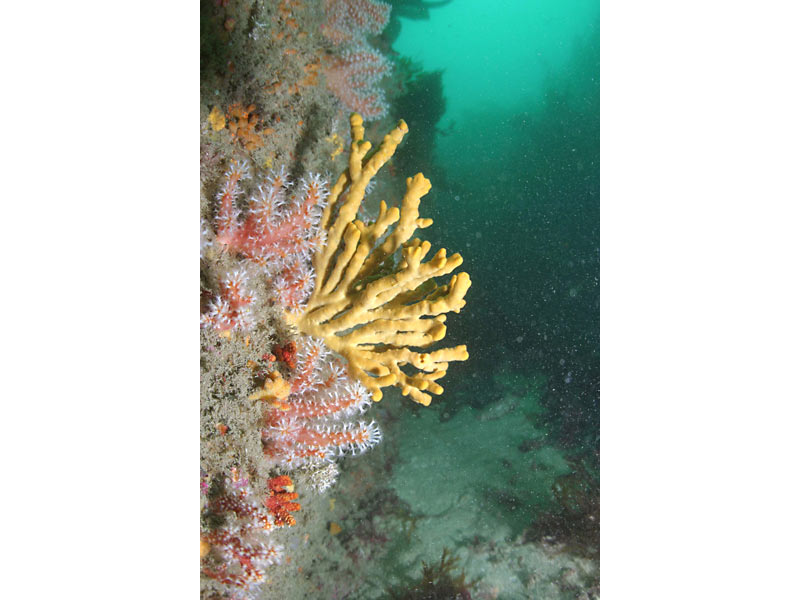Yellow staghorn sponge (Axinella dissimilis)
Distribution data supplied by the Ocean Biodiversity Information System (OBIS). To interrogate UK data visit the NBN Atlas.Map Help
| Researched by | Angus Jackson | Refereed by | This information is not refereed |
| Authority | (Bowerbank, 1866) | ||
| Other common names | - | Synonyms | Axinella polypoides Schmidt, 1862 |
Summary
Description
A medium sized, branching, finger-like sponge. Usually about 15 cm high and yellow / orange in colour. The branches are approximately oval and are rather irregular in diameter along their length, being typically around 1.5 cm. The sponge often branches in nearly the same plane forming a rough fan-shape. There is a short stem, rather thicker than the branches. The sponge surface has a velvety texture and is moderately firm but elastic.
Recorded distribution in Britain and Ireland
Present at a few sites around Mull, the south west of England and the western extremities of Wales. In Ireland there are records from the south east, the south west, and along the Atlantic coast round to the north east.Global distribution
South western British Isles, the Channel Isles, Atlantic coasts of France and Spain. Recorded also from Iceland.Habitat
Axinella dissimilis is typically found in exposed open coasts, on upward facing bedrock or other hard surfaces in the circalittoral zone.Depth range
? - 100+Identifying features
- A yellow / orange branching sponge about 15 cm in height.
- Skeletal spicules give the surface a velvety texture.
- Sponge surface cracks if bent more than 90 °C.
- A number of short, shallow grooves radiate from the oscula.
Additional information
Axinella polypoides is still used by some authors (e.g. Hayward and Ryland, 1995). However, Axinella polypoides is now considered to be a separate species confined to the Mediterranean (Howson & Picton, 1997). Axinella dissimilis may be confused with other branching sponges e.g. Stelligera stuposa and Raspailia hispida. However the relatively thicker branches and grooves surrounding the oscula are distinguishing features.
Listed by
- none -
Biology review
Taxonomy
| Level | Scientific name | Common name |
|---|---|---|
| Phylum | Porifera | Sponges |
| Class | Demospongiae | Siliceous sponges |
| Order | Axinellida | |
| Family | Axinellidae | |
| Genus | Axinella | |
| Authority | (Bowerbank, 1866) | |
| Recent Synonyms | Axinella polypoides Schmidt, 1862 | |
Biology
| Parameter | Data | ||
|---|---|---|---|
| Typical abundance | Moderate density | ||
| Male size range | up to 15cm | ||
| Male size at maturity | |||
| Female size range | Medium(11-20 cm) | ||
| Female size at maturity | |||
| Growth form | Fan-like | ||
| Growth rate | No information found | ||
| Body flexibility | High (greater than 45 degrees) | ||
| Mobility | |||
| Characteristic feeding method | Active suspension feeder, No information | ||
| Diet/food source | |||
| Typically feeds on | Suspended particulate matter. | ||
| Sociability | |||
| Environmental position | Epibenthic | ||
| Dependency | No information found. | ||
| Supports | No information found | ||
| Is the species harmful? | Data deficient | ||
Biology information
Size range refers to height. There is no information detailing whether the sexes are separate. Although elastic and flexible the surface of the sponge cracks if bent more than 90° (Moss & Ackers 1982). There is no information regarding the toxicity of this species.
Habitat preferences
| Parameter | Data |
|---|---|
| Physiographic preferences | Open coast, Offshore seabed |
| Biological zone preferences | Lower circalittoral, Lower infralittoral, Upper circalittoral |
| Substratum / habitat preferences | Bedrock, Large to very large boulders |
| Tidal strength preferences | |
| Wave exposure preferences | Exposed, Extremely exposed, Moderately exposed, Very exposed |
| Salinity preferences | Full (30-40 psu) |
| Depth range | ? - 100+ |
| Other preferences | No text entered |
| Migration Pattern | Non-migratory or resident |
Habitat Information
Konnecker (1977) also records Axinella dissimilis as an offshore species found on rock patches surrounded by shell gravel or coarse sand. In the Channel Islands, Brittany and Lough Hyne, Co. Cork the species also occurs on infralittoral bedrock (Picton & Costello, 1997). The sponge is recorded from depths of at least 100 m (Cabioch, 1968)Life history
Adult characteristics
| Parameter | Data |
|---|---|
| Reproductive type | No information |
| Reproductive frequency | No information |
| Fecundity (number of eggs) | No information |
| Generation time | Insufficient information |
| Age at maturity | Insufficient information |
| Season | Insufficient information |
| Life span | Insufficient information |
Larval characteristics
| Parameter | Data |
|---|---|
| Larval/propagule type | - |
| Larval/juvenile development | No information |
| Duration of larval stage | No information |
| Larval dispersal potential | No information |
| Larval settlement period | Insufficient information |
Life history information
No information is available regarding the longevity or reproductive mechanism of this species.Sensitivity review
The MarLIN sensitivity assessment approach used below has been superseded by the MarESA (Marine Evidence-based Sensitivity Assessment) approach (see menu). The MarLIN approach was used for assessments from 1999-2010. The MarESA approach reflects the recent conservation imperatives and terminology and is used for sensitivity assessments from 2014 onwards.
Physical pressures
Use / to open/close text displayed
| Intolerance | Recoverability | Sensitivity | Evidence / Confidence | |
Substratum loss [Show more]Substratum lossBenchmark. All of the substratum occupied by the species or biotope under consideration is removed. A single event is assumed for sensitivity assessment. Once the activity or event has stopped (or between regular events) suitable substratum remains or is deposited. Species or community recovery assumes that the substratum within the habitat preferences of the original species or community is present. Further details EvidenceThe species is permanently attached to the substratum. Substratum loss would result in the entire population. No information is available regarding the reproduction or dispersal abilities of this species so no assessment of recoverability can be made. Most sponges however, tend to be slow growing and long lived. | High | No information | High | High |
Smothering [Show more]SmotheringBenchmark. All of the population of a species or an area of a biotope is smothered by sediment to a depth of 5 cm above the substratum for one month. Impermeable materials, such as concrete, oil, or tar, are likely to have a greater effect. Further details. EvidenceAxinella dissimilis is an upright branching sponge up to 15 cm in height. Smothering by 5 cm of sediment may cover or damage some individuals of the population. No information is available regarding the reproduction or dispersal abilities of this species so no assessment of recoverability can be made. Most sponges however, tend to be slow growing and long lived. | Intermediate | No information | High | Low |
Increase in suspended sediment [Show more]Increase in suspended sedimentBenchmark. An arbitrary short-term, acute change in background suspended sediment concentration e.g., a change of 100 mg/l for one month. The resultant light attenuation effects are addressed under turbidity, and the effects of rapid settling out of suspended sediment are addressed under smothering. Further details EvidenceSponges are active particulate suspension feeders. Increases in deposition of suspended sediment may interfere with feeding, clogging pores and channels etc. Many sponges have cleaning mechanisms for dealing with siltation such as sloughing of outer cells or mucus production. No information is available regarding the reproduction or dispersal abilities of this species so no assessment of recoverability can be made. Most sponges however, tend to be slow growing and long lived. | Intermediate | No information | High | Low |
Decrease in suspended sediment [Show more]Decrease in suspended sedimentBenchmark. An arbitrary short-term, acute change in background suspended sediment concentration e.g., a change of 100 mg/l for one month. The resultant light attenuation effects are addressed under turbidity, and the effects of rapid settling out of suspended sediment are addressed under smothering. Further details Evidence | No information | |||
Desiccation [Show more]Desiccation
EvidenceThe species inhabits the lower infralittoral and circalittoral zones and as such is never exposed to the air. Desiccation, although unlikely, would probably result in death. No information is available regarding the reproduction or dispersal abilities of this species so no assessment of recoverability can be made. Most sponges however, tend to be slow growing and long lived. | High | No information | High | Low |
Increase in emergence regime [Show more]Increase in emergence regimeBenchmark. A one hour change in the time covered or not covered by the sea for a period of one year. Further details EvidenceThe species inhabits the lower infralittoral and circalittoral zones and as such is never subject to an emergence regime. Emergence, although unlikely, would probably result in death. No information is available regarding the reproduction or dispersal abilities of this species so no assessment of recoverability can be made. Most sponges however, tend to be slow growing and long lived. | High | No information | High | Low |
Decrease in emergence regime [Show more]Decrease in emergence regimeBenchmark. A one hour change in the time covered or not covered by the sea for a period of one year. Further details Evidence | No information | |||
Increase in water flow rate [Show more]Increase in water flow rateA change of two categories in water flow rate (view glossary) for 1 year, for example, from moderately strong (1-3 knots) to very weak (negligible). Further details EvidenceAxinella dissimilis inhabits rocky, wave exposed areas where water flow rate is potentially high. The species has an upright branching growth form protruding up in to water column. Large increases in water flow rate may interfere with the posture of the animal, cause physical damage. Reductions in water flow rate may affect feeding efficiency. No information is available regarding growth rates or recovery from physical damage. The cellular level of organisation in Porifera facilitates regeneration. | Low | No information | Moderate | Low |
Decrease in water flow rate [Show more]Decrease in water flow rateA change of two categories in water flow rate (view glossary) for 1 year, for example, from moderately strong (1-3 knots) to very weak (negligible). Further details Evidence | No information | |||
Increase in temperature [Show more]Increase in temperature
For intertidal species or communities, the range of temperatures includes the air temperature regime for that species or community. Further details EvidenceThere is no available information about the tolerance of Axinella dissimilis to changes in temperature. In the British Isles it has a mainly southern and western distribution. The species is found in warmer waters as far south as Spain. It is replaced in the Mediterranean by the very similar species, Axinella polypoides (Howson & Picton, 1997). Long term increases in temperature may cause extension of the British Isles populations and decreases in temperature may result in population shrinkage. Short term acute changes in temperature may also cause death. No information is available regarding the reproduction or dispersal abilities of this species so no assessment of recoverability can be made. Most sponges however, tend to be slow growing and long lived. | Intermediate | No information | High | Low |
Decrease in temperature [Show more]Decrease in temperature
For intertidal species or communities, the range of temperatures includes the air temperature regime for that species or community. Further details Evidence | No information | |||
Increase in turbidity [Show more]Increase in turbidity
EvidenceThe species has no ability for visual perception hence it is tolerant to changes in light penetration and attenuation. It is found at depths of at least 100 m (Cabioch, 1968) where light levels are low. | Tolerant | No information | Not sensitive | High |
Decrease in turbidity [Show more]Decrease in turbidity
Evidence | No information | |||
Increase in wave exposure [Show more]Increase in wave exposureA change of two ranks on the wave exposure scale (view glossary) e.g., from Exposed to Extremely exposed for a period of one year. Further details EvidenceAxinella dissimilis lives in wave exposed areas. Decreases in wave exposure may result in conditions outside the preferred range of the species and may cause shrinkage in population distribution. No information is available regarding the reproduction or dispersal abilities of this species so no assessment of recoverability can be made. Most sponges however, tend to be slow growing and long lived. | Intermediate | No information | High | Very low |
Decrease in wave exposure [Show more]Decrease in wave exposureA change of two ranks on the wave exposure scale (view glossary) e.g., from Exposed to Extremely exposed for a period of one year. Further details Evidence | No information | |||
Noise [Show more]Noise
EvidenceIt is unlikely that the species has any facility for detection of noise vibrations | Tolerant | No information | Not sensitive | Low |
Visual presence [Show more]Visual presenceBenchmark. The continuous presence for one month of moving objects not naturally found in the marine environment (e.g., boats, machinery, and humans) within the visual envelope of the species or community under consideration. Further details EvidenceThe species has no ability for visual perception hence it is not sensitive to visual disturbance. It is found at depths of at least 100 m (Cabioch, 1968) where light levels are low. | Tolerant | No information | Not sensitive | High |
Abrasion & physical disturbance [Show more]Abrasion & physical disturbanceBenchmark. Force equivalent to a standard scallop dredge landing on or being dragged across the organism. A single event is assumed for assessment. This factor includes mechanical interference, crushing, physical blows against, or rubbing and erosion of the organism or habitat of interest. Where trampling is relevant, the evidence and trampling intensity will be reported in the rationale. Further details. EvidenceThe species is quite elastic and flexible (Moss & Ackers, 1982). However, if the sponge is bent more than 90 ° the surface will crack. The sponge branches upright into the water column. Abrasion may physically damage or dislodge the sponge. No information is available regarding the reproduction or dispersal abilities of this species so no assessment of recoverability can be made. Most sponges however, tend to be slow growing and long lived. | Intermediate | No information | High | Low |
Displacement [Show more]DisplacementBenchmark. Removal of the organism from the substratum and displacement from its original position onto a suitable substratum. A single event is assumed for assessment. Further details EvidenceThe species is permanently attached to the substratum. It is unlikely to be able to reform this attachment if displaced. No information is available regarding the reproduction or dispersal abilities of this species so no assessment of recoverability can be made. Most sponges however, tend to be slow growing and long lived. | High | No information | High | Low |
Chemical pressures
Use [show more] / [show less] to open/close text displayed
| Intolerance | Recoverability | Sensitivity | Evidence / Confidence | |
Synthetic compound contamination [Show more]Synthetic compound contaminationSensitivity is assessed against the available evidence for the effects of contaminants on the species (or closely related species at low confidence) or community of interest. For example:
The evidence used is stated in the rationale. Where the assessment can be based on a known activity then this is stated. The tolerance to contaminants of species of interest will be included in the rationale when available; together with relevant supporting material. Further details. EvidenceInsufficientinformation | No information | No information | No information | Not relevant |
Heavy metal contamination [Show more]Heavy metal contaminationEvidenceInsufficientinformation | No information | No information | No information | Not relevant |
Hydrocarbon contamination [Show more]Hydrocarbon contaminationEvidenceInsufficientinformation | No information | No information | No information | Not relevant |
Radionuclide contamination [Show more]Radionuclide contaminationEvidenceInsufficientinformation | No information | No information | No information | Not relevant |
Changes in nutrient levels [Show more]Changes in nutrient levelsEvidenceInsufficientinformation | No information | No information | No information | Not relevant |
Increase in salinity [Show more]Increase in salinity
EvidenceThe species inhabits open coasts and off-shore areas where salinity is likely to be full. Decreases in salinity will result in conditions outside the preferred range for the species, probably causing death.. | High | No information | High | Low |
Decrease in salinity [Show more]Decrease in salinity
Evidence | No information | |||
Changes in oxygenation [Show more]Changes in oxygenationBenchmark. Exposure to a dissolved oxygen concentration of 2 mg/l for one week. Further details. EvidenceThere is no information regarding the tolerance of Axinella dissimilis to changes in oxygen concentration. However, Cole et al., (1999) suggest possible adverse effects on marine species below 4 mg/l and probable adverse effects below 2mg/l. No information is available regarding the reproduction or dispersal abilities of this species so no assessment of recoverability can be made. Most sponges however, tend to be slow growing and long lived. | Intermediate | No information | High | Low |
Biological pressures
Use [show more] / [show less] to open/close text displayed
| Intolerance | Recoverability | Sensitivity | Evidence / Confidence | |
Introduction of microbial pathogens/parasites [Show more]Introduction of microbial pathogens/parasitesBenchmark. Sensitivity can only be assessed relative to a known, named disease, likely to cause partial loss of a species population or community. Further details. EvidenceInsufficientinformation | No information | No information | No information | Not relevant |
Introduction of non-native species [Show more]Introduction of non-native speciesSensitivity assessed against the likely effect of the introduction of alien or non-native species in Britain or Ireland. Further details. EvidenceInsufficientinformation | No information | No information | No information | Not relevant |
Extraction of this species [Show more]Extraction of this speciesBenchmark. Extraction removes 50% of the species or community from the area under consideration. Sensitivity will be assessed as 'intermediate'. The habitat remains intact or recovers rapidly. Any effects of the extraction process on the habitat itself are addressed under other factors, e.g. displacement, abrasion and physical disturbance, and substratum loss. Further details. EvidenceAs this sponge species has no current commercial, culinary or research value, it is unlikely that it will be exploited and extracted. | Not relevant | Not relevant | Not relevant | Low |
Extraction of other species [Show more]Extraction of other speciesBenchmark. A species that is a required host or prey for the species under consideration (and assuming that no alternative host exists) or a keystone species in a biotope is removed. Any effects of the extraction process on the habitat itself are addressed under other factors, e.g. displacement, abrasion and physical disturbance, and substratum loss. Further details. EvidenceAxinella dissimilis has no known obligate relationships so the loss of other species is unlikely to have an impact. | Tolerant | No information | Not sensitive | Very low |
Additional information
Importance review
Policy/legislation
- no data -
Status
| National (GB) importance | - | Global red list (IUCN) category | - |
Non-native
| Parameter | Data |
|---|---|
| Native | - |
| Origin | - |
| Date Arrived | - |
Importance information
Axinella dissimilis may occur amongst quite dense assemblages of animals but there is no information regarding actual abundances (Cabioch, 1968). Many sponges provide shelter for small organisms such as shrimps but there are no records of such with Axinella dissimilis.Bibliography
Bowerbank, J.S., 1865. A monograph of the British Spongiadae, vol. II. London: Ray Society.
Cabioch, L., 1968. Contribution a la connaissance des peuplements benthiques de la Manche occidentale. Cahiers de Biologie Marine, 9, 493 - 720.
Howson, C.M. & Picton, B.E., 1997. The species directory of the marine fauna and flora of the British Isles and surrounding seas. Belfast: Ulster Museum. [Ulster Museum publication, no. 276.]
JNCC (Joint Nature Conservation Committee), 1999. Marine Environment Resource Mapping And Information Database (MERMAID): Marine Nature Conservation Review Survey Database. [on-line] http://www.jncc.gov.uk/mermaid
Konnecker, G., 1973. Littoral and benthic investigations on the west coast of Ireland - I. Section A: Faunistic and Ecological Studies. The sponge fauna of Kilkieran Bay and adjacent area. Proceedings of the Royal Irish Academy, 73(B), 451 - 472.
Moss, D., & Ackers, G. (eds.), 1982. The UCS Sponge Guide. Produced by R. Earll. Ross-on-Wye: The Underwater Conservation Society.
Picton, B.E. & Costello, M.J., 1998. BioMar biotope viewer: a guide to marine habitats, fauna and flora of Britain and Ireland. [CD-ROM] Environmental Sciences Unit, Trinity College, Dublin.
Datasets
Centre for Environmental Data and Recording, 2018. Ulster Museum Marine Surveys of Northern Ireland Coastal Waters. Occurrence dataset https://www.nmni.com/CEDaR/CEDaR-Centre-for-Environmental-Data-and-Recording.aspx accessed via NBNAtlas.org on 2018-09-25.
NBN (National Biodiversity Network) Atlas. Available from: https://www.nbnatlas.org.
OBIS (Ocean Biodiversity Information System), 2024. Global map of species distribution using gridded data. Available from: Ocean Biogeographic Information System. www.iobis.org. Accessed: 2024-04-25
Citation
This review can be cited as:
Last Updated: 17/04/2008

